 The Queen Mother 4th August 1900 - 30th March 2002 |
 The Queen Mother 4th August 1900 - 30th March 2002 |
Picture coutesy of The Press Association |
H.M. Queen Elizabeth, The Queen MotherEarly DaysLady Elizabeth Angela Marguerite Bowes-Lyon, was born on August 4th, 1900, at the family home at St Paul's Waldenbury. Her parents were the Earl and Countess of Strathmore and Kinghorne. She spent much of her youth at Glamis Castle, the Scottish family seat of the Strathmore family and almost all of her education was at home, although for a short while she spent time at a day school in London. Elizabeth was a keen needlewoman, enjoyed cooking and music as well as the outdoor activities of 'a well-bred gentlewoman' to quote a newspaper of the day. At Glamis she learnt to put duty to others before herself and during the First World War, The Great War, was actively involved in the nursing of injured soldiers from 'the trenches' when Glamis Castle was turned into a military hospital. Although too young to be a nurse she helped in many other ways, often writing letters and playing cards with the patients. She would have experienced personally at a young age the great sadness of losing a member of the family when her brother, Fergus, was killed in battle. Another brother, Michael, was held prisoner for two years. There is no doubt that Elizabeth captured the hearts of the nation the moment she married The Duke of York on April 26th 1923. This was a little before her 24th birthday, and just three months after their engagement had been announced. 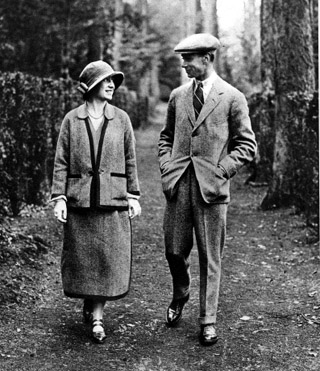 It is said that Lady Elizabeth had refused Prince Albert's original proposal of marriage on three earlier occasions but there is no doubt that theirs was a truly happy marriage and now, as The Duchess of York, she gave birth to two children. Princess Elizabeth, (to become HM Queen Elizabeth II) was born on April 21st 1926 and christened Elizabeth Alexandra Mary, and Princess Margaret Rose who was born on August 21st 1930 and died on 9th February 2002. In 1931 The Duke and Duchess of York, now with two young daughters, were looking for a quiet retreat in the country away from their London home and new-found press interest. They decided upon Royal Lodge in Windsor Great Park and it is there that the two princesses spent much of their childhood with their parents. It is therefore for over 70 years that special links have existed between Windsor, the late King George VI, our present Queen and The Queen Mother. Throughout the early years of their marriage, both The Duke and the Duchess worked long and hard on a wide variety of public engagements and projects. For example, they visited factories and industrial centres, he becoming known as the "Industrial Prince". He founded The Duke of York's Camp (associated with the Industrial Welfare Society of which he was President), and he became President also of the National Playing Fields Association, Much of the newsreel footage of the time shows him enthusiastically joining in with all the other participants in a variety of camps for young people from all backgrounds. Both the Duke and the Duchess were keen supporters of the Scouts and Guides, both in the UK and abroad. 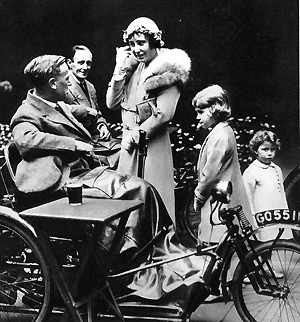
George VIThe Early Days as Duke of YorkThe young Prince Albert was an excellent sportsman, having 'the quickest eye for a ball in the family'. He enjoyed golf and especially tennis, playing in the men's doubles at Wimbledon in 1926. He was born at Sandringham on December 14th 1895 and had been educated for the Navy, a career he chose for himself. He entered the Navy as an ordinary cadet and although he did not excel in other studies, his seamanship was first rate. Examinations, he confessed later usually found him 'at the bottom of the list." But when handling a boat he excelled. Prince Albert saw active service during the First World War aboard HMS Collingwood during the Battle of Jutland. He later suffered gastric trouble and eventually had to undergo an operation for a duodenal ulcer which put paid to his naval career. He transferred to the Royal Naval Air Station at Cranwell to be one of the first officers to be absorbed into the Royal Air Force when the naval arm combined with the Royal Flying Corps. Combining royal engagements with his flying training, he gained his wings in 1919, by all accounts taking his final test in poor weather, contrary to strong advice. At this time Albert specialised in social and industrial work at home, a subject that was a natural interest to him, and not a duty. It must be said that he suffered from a stutter, at times quite serious, and although he did not make friends as readily as his older brother, his concern for living conditions and problems in various parts of the country led people to appreciate his genuine concerns. In 1920 Prince Albert was created Duke of York and at this time already knew Lady Elizabeth Bowes-Lyon. He was obviously in love with her and on several occasions asked her to marry him, but it was to be three years before she accepted his latest proposal, marrying after a three month engagement on April 26th 1923. Queen Mary, wife of George V said of her, "She is not one of these modern girls, thank Heaven!". Throughout the late twenties and thirties the Duke and Duchess of York went about their public duties very conscientiously, and although the Duke did not receive so much press attention as his older brother, his wife and young daughters were regularly featured. 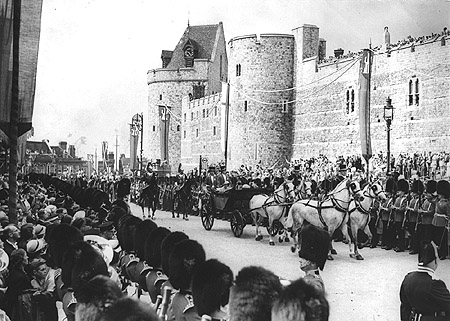 The Abdication CrisisThe Major Turning Point in the life of The Queen MotherThe scenes illustrated here, below the walls of Windsor Castle, marked not only a major turning point in the Queen Mother's life but also for the monarchy in the United Kingdom. For it was in Windsor Great Park, at Fort Belvedere, not London, that the final momentous climax of the Abdication Crisis was played out, and which led to the Duchess of York's husband becoming King George VI and her to become Queen Elizabeth. 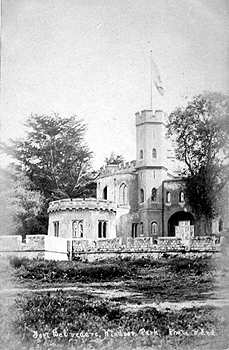
In an 'Instrument of Abdication' dated 10th December 1936, Edward VIII had renounced the throne of England in order to marry Mrs Simpson, an American divorcee. The 'Instrument' reads:
(Capitalisation is as the original) The Instrument was signed by Edward VIII and his three brothers, Albert, previously Duke of York and now succeeding as George VI, Prince Henry, Duke of Gloucester, and Prince George, Duke of Kent. The Abdication was the climax to a major constitutional crisis in the life of the UK giving rise to newspaper headlines such as "The King: Cabinet Crisis" and "The King: Grave Issues". It is also certain that Queen Elizabeth had no desire either for her husband to become king or for her daughter, Princess Elizabeth, to one day inherit the throne. With the Abdication their lives were to change substantially. One can only guess at the conversations between The Duke of York, his wife, and Edward VIII towards the end of 1936 as Edward wrestled with his responsibilities and duties as King and with his love for Mrs Simpson. He had acceded to the throne on 20th January 1936 following the death of George V at Sandringham less than a year earlier. He had immediately made significant changes to royal procedures, such as being the first monarch to accept that flying had become sufficiently risk-free that it could become routine, and that he should make impromptu visits to the homes of ordinary people as a part of his public duties. He was not however comfortable with the prospect of a lifetime undertaking royal duties, while at the same time he had the impossible constitutional difficulties associated with marrying the divorcee, Mrs Simpson. Towards the end of 1936, as the constitutional crisis deepened, Mrs Simpson obtained a divorce, and although her name had appeared regularly in the Court Circular as a guest at Buckingham Palace, and had cruised with the Duke in the Mediterranean on the yacht 'Nahlin', little had been reported in the English papers. By October, however, reports in the American press caused alarm in London, such that Prime Minister Baldwin discussed the matter personally with King Edward VIII. The problems were many, not least that in the event of a royal marriage, Mrs Simpson would become Queen, a prospect that, as a divorcee, would at that time have been totally unacceptable to the public, the church and parliament, both at home as well as overseas. As King, Edward was head of the Church of England, 'Defender of the Faith', and was expected and required to uphold religious belief. Marriage to a divorcee was therefore quite out of the question. Only in early December were the stories and rumours finally confirmed by the newspapers in the UK and for 10 days the matter was on everyone's lips. It is said that "The Empire rocked on its very foundations" and, as the crisis gathered momentum, Mrs Simpson left for France. Despite much diplomatic manoeuvering throughout the early days of that month, it eventually became clear to Edward VIII that he had no option but to abdicate, no other acceptable alternatives being open to him. At 10pm on 11th December 1936, Sir John Reith of the BBC came over the airwaves. "This is Windsor Castle," he said. "His Royal Highness Prince Edward". The nation was shocked. Prince Edward! Then the former king spoke quietly to the waiting world stating that he had abdicated in order to be with "the woman I love." After the broadcast, the BBC closed down for the night and Edward was driven to Portsmouth where the waiting destroyer HMS Fury slipped out of harbour bound for Boulogne with the ex-King on board. On December 14, 1936 he was reported to be in Vienna, Austria, where he was staying with Baroness Rothschild, the newspapers already referring to him as The Duke of Windsor. There is more about Edward VIII, including the Abdication Speech, here. 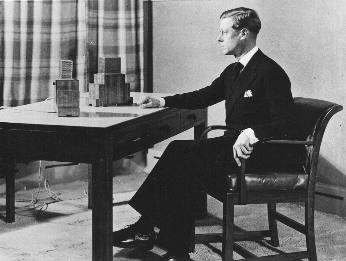
After The Abdication and the War YearsIn December 1936, The Duke of York had become King George VI and his wife, his Queen Consort. It is fortunate for the monarchy, and for the United Kingdom, that the queen was the woman she was, and the king the man he was, for, as the next 15 years were to show, they restored the image of the Monarchy and earned the love and respect of the nation, especially in the war years. The King and Queen were a very happy couple, with two delightful daughters, and it is no doubt that the King relied heavily upon the staunch support and encouragement of his Queen in the totally unexpected position they both now found themselves in. They succeeded magnificently and this is primarily due to the influence of Queen Elizabeth. At what point the family became aware of the great challenge that lay ahead of them is unclear, and it may be that Edward VIII's decision to abdicate was taken in a very short time indeed once the pressures became too great. The Duchess of York would doubtless have prayed that her family be spared the huge responsibilities of the monarchy, but it was not to be, so as 1937 dawned, Elizabeth found her 'beloved Bertie', succeeding as King George VI, a situation that it is very likely they both had dreaded. However, it must also be said that both the King and Queen undertook their new duties with a high degree of responsibility. 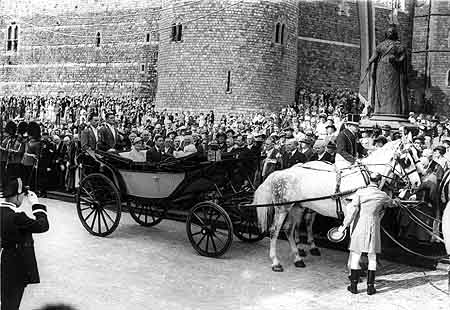
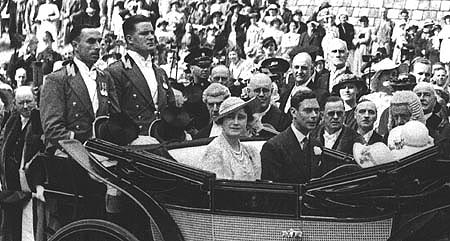
Initially the new King and his Queen were not often seen in public. It was reported at the time that for the first two months of his reign he was, with characteristic thoroughness, learning all he could of his new role, and the expectations of the State. Those appearances that he did make included an exhausting tour of the The British Industries Fair at the White City, with Queen Elizabeth and Queen Mary, his mother. In March, George VI and Queen Elizabeth were to be seen at the Grand National at Aintree and the next day in Liverpool, where they were greeted enthusiastically. He seemed more assured, losing the nervousness that he displayed as a younger man. George was rising to the requirements of the job, with the substantial support and encouragement of his wife, and the public appreciated his dedication. Queen Elizabeth remained ever popular whilst a dignity and poise crept into her jolly manner. George VI had a major problem to contend with and that was his obvious stutter when speaking in public. He made great advances in trying to overcome this affliction, and in later years it was all but overcome, but in the first few years of his reign, it weighed heavily on his mind. George was also a smoker, and a heavy one at that. In his youth there was almost no concern over the health implications of smoking, it was totally acceptable, with cigarettes being offered around in every social gathering without a second thought. It was, however, to lead to his early death, compounded by the strain and worry of his position. Even in the early days of his reign George VI's health was not perfect, and Queen Elizabeth knew that he should take things carefully, but even though he retreated to Windsor for much of the time in the period of preparation prior to the Coronation, that did not prevent him from meeting upwards of 30, sometimes 70, people in a day. On 23rd April 1937, St George's Day, George VI unveiled the George V Memorial at the foot of the castle walls at Windsor, where it is said he made his first public speech since becoming king. [Unveiling Memorial and Speech] The Coronation was by now little more than three weeks away and it was reported by the Daily Express newspaper at the time that "It was an exhausting period, but the King survived it triumphantly and when May 12th arrived, was able to sustain his burden as the central figure in the great pageant of the Coronation with assurance and dignity." In 2003 an illuminating letter was released and is now available to view in The National Archive, ref. PREM1/467. The letter, handwritten by George VI, was sent to The Prime Minister at the time, Neville Chamberlain. It is dated December 14th 1938 and discusses 'my brother in Paris', the Duke of Windsor. In the letter George VI states that he had 'heard from all sides that there was strong feeling amongst all classes that my brother should not return here even for a short visit with the Duchess of Windsor... it would not be at all wise for him to contemplate such a visit.' George VI goes on to write that 'neither the Queen nor Queen Mary have any desire to meet the Duchess of Windsor and therefore any visit made for the purpose of introducing her to members of the Royal Family obviously becomes impossible.' George VI suggests that this decision would be taken 'in a more kindly manner from you than from me! Believe me, Yours very sincerely, George RI'. In other words, the king is of the view that the Prime Minister should tell the Duke of Windsor not to make plans to come to the UK. The National Archives includes other letters on the subject. Although the strain between the Royal Family and the Duke and Duchess of Windsor could be guessed at, it was kept in the background for many years. In the meantime a new image was fostered of the Royal Family, an image that the public took to wholeheartedly. There is no doubt that Elizabeth and George VI were devoted to each other and their two children and this great affection was appreciated not just by the British, but around the world. After only two years on the throne, George VI and his consort were plunged into war with Germany. Although many of the Royal Family's relations were German, and indeed the ex-king Edward VIII was known to spend much of his time in Germany, it is absolutely certain that George VI and Elizabeth were unshakably committed to the war effort against the Fascists. They refused to allow their children, the princesses Elizabeth and Margaret, to leave the UK, "The children won't leave without me, I won't leave without the king, and the king will never leave," Queen Elizabeth said, so although many children were being evacuated to farms and other homes around the country, and even overseas to Canada, they themselves remained at home, either at Windsor or at Buckingham Palace, even though London was under heavy bombing for much of the early part of the war. It was seemingly with delight, certainly relief, when Buckingham Palace received a direct hit and the Royal Family were able to announce, as they toured the East End of London after a night of particularly heavy bombing, that now they knew exactly how the East Enders felt as their home too had been bombed! The Queen Mother told of how she and the King had actually seen the bomb fall, as they were only a matter of a hundred or so metres away. Their total commitment to royal duties endeared the King and Queen to the public, and this fondness endured long after the death of the King in 1952.
The King's untimely death, when The Queen Mother was only 51, was a devastating blow to her. For a while she understandably wanted to retreat from public life but, with encouragement from Winston Churchill, the then Prime Minister, Queen Elizabeth returned to public life. The fact that she 'reinvented' herself within a few months as The Queen Mother, in support of her daughter, now Queen Elizabeth II, was testimony to her loyalty and devotion to her royal duties, working tirelessly and undertaking countless engagements. In the following 50 years, The Queen Mother undertook engagements both in the UK and overseas and even at the age of 101 was to be seen at a public engagement in Portsmouth aboard HMS Ark Royal, a British aircraft carrier, where she was greeted enthusiastically by the entire ship's company. Even into her eighties she was undertaking 150 engagements annually, with the attendant 'homework' beforehand, and in her 90s was still actively involved in at least one engagement a week, such was her strong sense of duty. This sense of duty has been passed on to her daughter Queen Elizabeth II, and her grandsons, especially Prince Charles who continues the precedent set by his grandmother, and to whom he was very close.
|
London Funeral |
from 1066 |